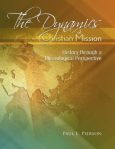Paul Pierson’s The Dynamics of Christian Mission consists of lectures on Christian history from a class he taught for twenty-five years at Fuller Theological Seminary’s School of Intercultural Studies.
Like other books of this sort, it narrates the history of the expansion of Christianity from the apostolic era to the present, dividing that history into six sections. “Early Expansion” (chapters 1–7) traces the story from the apostolic era through the rise of the Celtic church. “Change and Attempts at Renewal” (chapters 8–12) examine the Middle Ages. “The Reformation Era” (chapters 13–16) focuses on the missionary efforts of the Protestant Reformation and Catholic Counter-Reformation. “Renewal and the Beginnings of Protestant Reformation” (chapters 17–22) takes up the story in the seventeenth century with Puritans in the British Isles and Pietists on the European continent and ends with revival movements on the American frontier. “The ‘Great Centuries’” (chapters 23–30. examines evangelical missionary efforts in the late nineteenth and early twentieth centuries, dividing its material into geographical regions: Asia (chapter 26); Oceania, the Middle East, and North Africa (chapter 27); Africa (chapter 28); and Latin America (chapter 29). “The New Era (chapters 31–35) conclude the story with chapters on how missions is changing in the contemporary era.
Pierson’s historical narrative is conventional, focused on European and North American missions, especially evangelical missions. The real value of the work lies less in its narrative than in its interpretation of what the book’s title calls “the dynamics of Christian mission.” Pierson makes explicit in the Preface that this interpretation is the “purpose of this work”: “To study church history in a way that will encourage you to appreciate the importance of the dynamic principles underlying the expansion of the Christian movement” (p. 5).
He then goes on to identify eight dynamics—he calls them “theses”—in particular (pp. 6–7), which he draws attention to repeatedly throughout the historical narrative that follows:
- “Movements of renewal and mission always seem to arise on the periphery of the church structures.”
- “Congregational structures [i.e., modality] and mission structures [i.e., sodality] are essential to the completion of the mission of the Church to the end of history and that both are equally the Church, the People of God.”
- “A key leader has triggered most mission movements.”
- “Mission has normally come out of renewal.”
- “Movements of renewal and mission have often involved theological breakthroughs: a discovery or rediscovery of a previously unrealized or forgotten aspect of biblical faith.”
- “The historical context of mission movements is important. The mission does not change, but the context in which God calls us to carry out our mission changes constantly. This opens up new and creative possibilities for sharing the Gospel.”
- “New, more contextualized forms of spirituality are often a characteristic of the movements we will study.”
- “Finally, the distribution of information has often been important. News of new initiatives in mission or renewal has often stimulated similar movements in other places.”
The identification of these theses or dynamics demonstrates the enduring value of Pierson’s work for missiologists, more so than his historical narrative, which as already noted, is conventional, though competent.
 Book Reviewed
Book Reviewed
Paul Pierson, The Dynamics of Christian Mission: History through a Missiological Perspective (Pasadena, CA: William Carey International University Press, 2009).
P.S. If you found this review helpful, please vote “Yes” on my Amazon.com review page.

